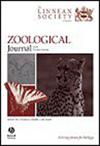Geometric morphometrics of silky pocket mice (Perognathus: Perognathinae: Rodentia) crania reveals new insights into their variation, evolution, and taxonomy
IF 3
2区 生物学
Q1 ZOOLOGY
引用次数: 0
Abstract
We used cranial geometric morphometric methods (GMM) to explore interspecific variation in Perognathus (silky pocket mice). We digitized 67 cranial landmarks on photographs of 305 adult voucher specimens (10 species and 33 subspecies, 121 localities). After summarizing variation patterns, we explored their association with biological, ecological, and climatic factors, and how (and why) shape evolved through time. Phenotypic clusters did not accord with phylogenetic clades, and we found instances of convergence, divergence, and increased rates of shape change. These are discussed in terms of shared selective pressures (e.g. habitat substrate and burrowing plus historic shifts in habitat/climate and desert adaptation). We also used variation patterns and phenetics to address ongoing taxonomic issues. While pocket mice are difficult to distinguish externally, GMM allowed us to precisely characterize interspecific cranial variation. Species significantly differed and could be classified based on their shape. We find P. alticola to be the most cranially distinct species and suggest raising the P. alticola + P. parvus (including P. mollipilosus) cluster/clade to subgenus status (=Cricetodipus). Cranial GMM found differences among taxa that seemed similar (i.e. cryptic) when previously explored using linear measurements (e.g. P. parvus vs. P. mollipilosus).丝袋鼠(Perognathus: Perognathinae: Rodentia)头盖骨的几何形态计量揭示了其变异、进化和分类的新见解
我们使用颅骨几何形态计量方法(GMM)来探索袋鼠(Perognathus)的种间变异。我们对 305 个成年凭证标本(10 个种和 33 个亚种,121 个地点)照片上的 67 个颅骨地标进行了数字化处理。在总结了变异模式之后,我们探讨了它们与生物、生态和气候因素的关联,以及形状如何(以及为何)随时间演变。表型集群与系统发育支系并不一致,我们发现了聚合、分化和形状变化率增加的情况。我们从共同的选择性压力(如栖息地基质和穴居,以及栖息地/气候和沙漠适应性的历史性转变)的角度讨论了这些问题。我们还利用变异模式和表型学来解决目前的分类问题。袖珍鼠的外部特征很难区分,而 GMM 使我们能够精确描述种间头骨变异的特征。物种之间存在明显差异,可以根据其形状进行分类。我们发现 P. alticola 是颅骨差异最大的物种,并建议将 P. alticola + P. parvus(包括 P. mollipilosus)群/支系提升到亚属地位(=Cricetodipus)。颅骨 GMM 发现了分类群之间的差异,而这些差异在以前使用线性测量时似乎是相似的(即隐蔽的)(例如 P. parvus vs. P. mollipilosus)。
本文章由计算机程序翻译,如有差异,请以英文原文为准。
求助全文
约1分钟内获得全文
求助全文
来源期刊
CiteScore
6.50
自引率
10.70%
发文量
116
审稿时长
6-12 weeks
期刊介绍:
The Zoological Journal of the Linnean Society publishes papers on systematic and evolutionary zoology and comparative, functional and other studies where relevant to these areas. Studies of extinct as well as living animals are included. Reviews are also published; these may be invited by the Editorial Board, but uninvited reviews may also be considered. The Zoological Journal also has a wide circulation amongst zoologists and although narrowly specialized papers are not excluded, potential authors should bear that readership in mind.

 求助内容:
求助内容: 应助结果提醒方式:
应助结果提醒方式:


